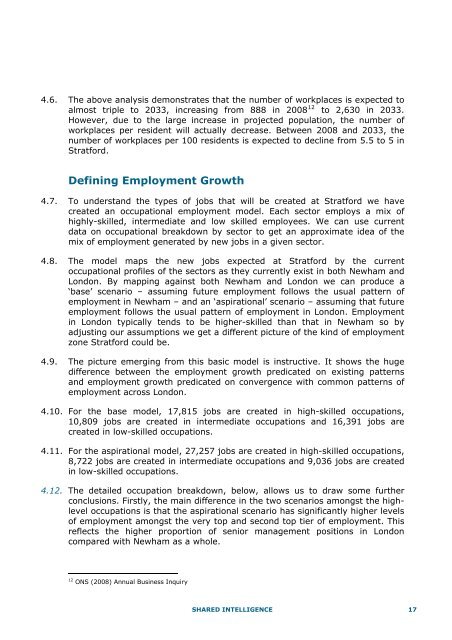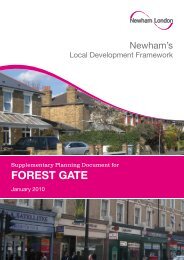Stratford Masterplan: Socio-economic impact paper - Newham
Stratford Masterplan: Socio-economic impact paper - Newham
Stratford Masterplan: Socio-economic impact paper - Newham
You also want an ePaper? Increase the reach of your titles
YUMPU automatically turns print PDFs into web optimized ePapers that Google loves.
4.6. The above analysis demonstrates that the number of workplaces is expected to<br />
almost triple to 2033, increasing from 888 in 2008 12 to 2,630 in 2033.<br />
However, due to the large increase in projected population, the number of<br />
workplaces per resident will actually decrease. Between 2008 and 2033, the<br />
number of workplaces per 100 residents is expected to decline from 5.5 to 5 in<br />
<strong>Stratford</strong>.<br />
Defining Employment Growth<br />
4.7. To understand the types of jobs that will be created at <strong>Stratford</strong> we have<br />
created an occupational employment model. Each sector employs a mix of<br />
highly-skilled, intermediate and low skilled employees. We can use current<br />
data on occupational breakdown by sector to get an approximate idea of the<br />
mix of employment generated by new jobs in a given sector.<br />
4.8. The model maps the new jobs expected at <strong>Stratford</strong> by the current<br />
occupational profiles of the sectors as they currently exist in both <strong>Newham</strong> and<br />
London. By mapping against both <strong>Newham</strong> and London we can produce a<br />
‘base’ scenario – assuming future employment follows the usual pattern of<br />
employment in <strong>Newham</strong> – and an ‘aspirational’ scenario – assuming that future<br />
employment follows the usual pattern of employment in London. Employment<br />
in London typically tends to be higher-skilled than that in <strong>Newham</strong> so by<br />
adjusting our assumptions we get a different picture of the kind of employment<br />
zone <strong>Stratford</strong> could be.<br />
4.9. The picture emerging from this basic model is instructive. It shows the huge<br />
difference between the employment growth predicated on existing patterns<br />
and employment growth predicated on convergence with common patterns of<br />
employment across London.<br />
4.10. For the base model, 17,815 jobs are created in high-skilled occupations,<br />
10,809 jobs are created in intermediate occupations and 16,391 jobs are<br />
created in low-skilled occupations.<br />
4.11. For the aspirational model, 27,257 jobs are created in high-skilled occupations,<br />
8,722 jobs are created in intermediate occupations and 9,036 jobs are created<br />
in low-skilled occupations.<br />
4.12. The detailed occupation breakdown, below, allows us to draw some further<br />
conclusions. Firstly, the main difference in the two scenarios amongst the highlevel<br />
occupations is that the aspirational scenario has significantly higher levels<br />
of employment amongst the very top and second top tier of employment. This<br />
reflects the higher proportion of senior management positions in London<br />
compared with <strong>Newham</strong> as a whole.<br />
12 ONS (2008) Annual Business Inquiry<br />
SHARED INTELLIGENCE 17

















